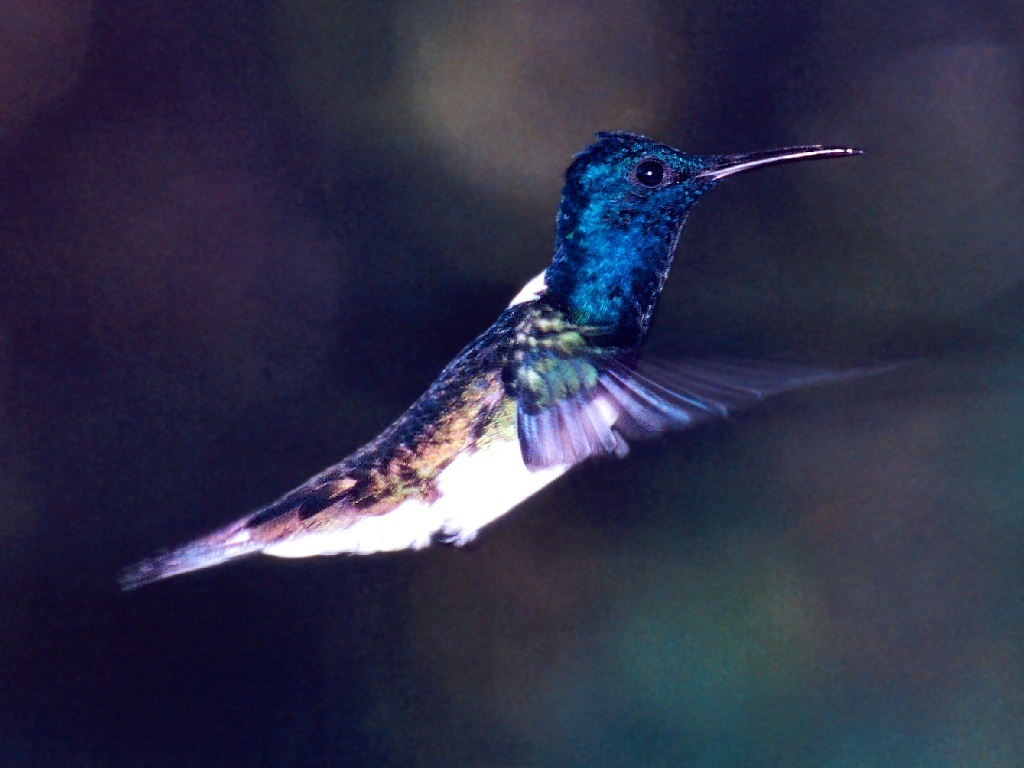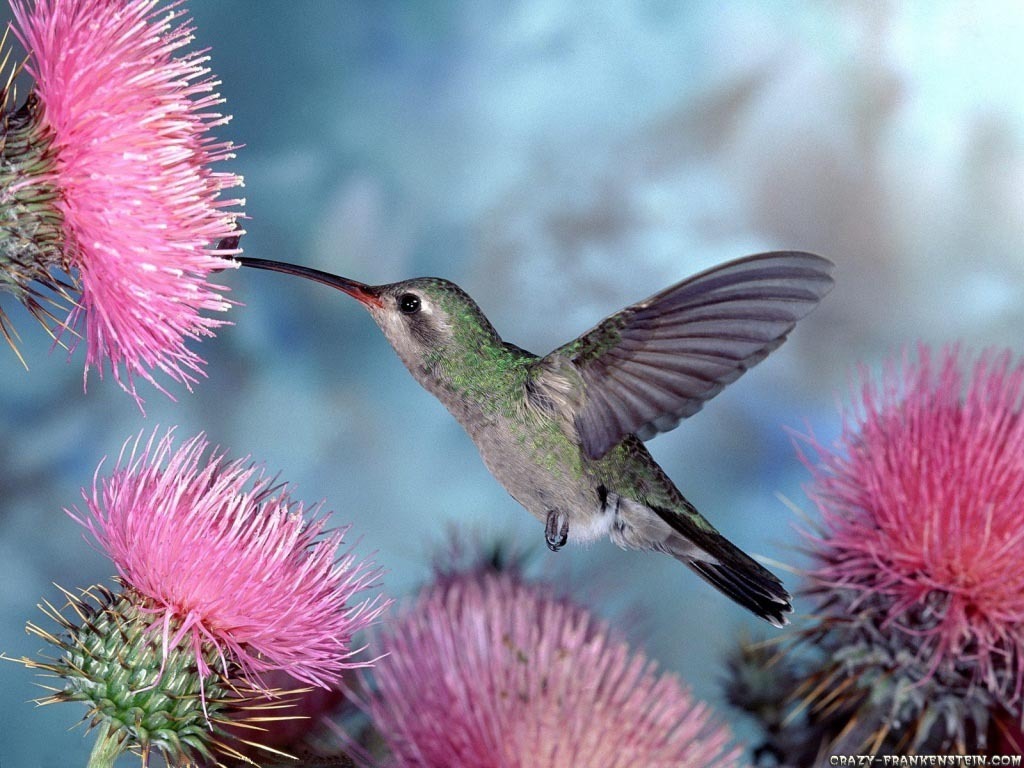Hummingbird Wallpaper Biography
.Hummingbirds drink nectar, a sweet liquid inside certain flowers. Like bees, they are able to assess the amount of sugar in the nectar they eat; they reject flower types that produce nectar that is less than 10% sugar and prefer those whose sugar content is stronger. Nectar is a poor source of nutrients, so hummingbirds meet their needs for protein, amino acids, vitamins, minerals, etc. by preying on insects and spiders.[3]
Most hummingbirds have bills that are long and straight or nearly so, but in some species the bill shape is adapted for specialized feeding. Thornbills have short, sharp bills adapted for feeding from flowers with short corollas and piercing the bases of longer ones. The Sicklebills' extremely decurved bills are adapted to extracting nectar from the curved corollas of flowers in the family Gesneriaceae. The bill of the Fiery-tailed Awlbill has an upturned tip, as in the Avocets. The male Tooth-billed Hummingbird has barracuda-like spikes at the tip of its long, straight bill.
The two halves of a hummingbird's bill have a pronounced overlap, with the lower half (mandible) fitting tightly inside the upper half (maxilla). When hummingbirds feed on nectar, the bill is usually only opened slightly, allowing the tongue to dart out and into the interior of flowers.
Like the similar nectar-feeding sunbirds and unlike other birds, hummingbirds drink by using protrusible grooved or trough-like tongues.[4] Hummingbirds do not spend all day flying, as the energy cost would be prohibitive; the majority of their activity consists simply of sitting or perching. Hummingbirds feed in many small meals, consuming many small invertebrates and up to twelve times their own body weight in nectar each day. They spend an average of 10–15% of their time feeding and 75–80% sitting and digesting.
With the exception of insects, hummingbirds while in flight have the highest metabolism of all animals, a necessity in order to support the rapid beating of their wings. Their heart rate can reach as high as 1,260 beats per minute, a rate once measured in a Blue-throated Hummingbird.[12] They also consume more than their own weight in nectar each day, and to do so they must visit hundreds of flowers daily. Hummingbirds are continuously hours away from starving to death, and are able to store just enough energy to survive overnight.
Hummingbirds are capable of slowing down their metabolism at night, or any other time food is not readily available. They enter a hibernation-like state known as torpor. During torpor, the heart rate and rate of breathing are both slowed dramatically (the heart rate to roughly 50 to 180 beats per minute), reducing the need for food.
The dynamic range of metabolic rates in hummingbirds[14] requires a corresponding dynamic range in kidney function.[15] The glomerulus is a cluster of capillaries in the nephrons of the kidney that removes certain substances from the blood, like a filtration mechanism. The rate at which blood is processed is called the glomerular filtration rate (GFR). Most often these fluids are reabsorbed by the kidneys. During torpor, to prevent dehydration, the GFR slows, preserving necessities for the body such as glucose, water and salts. GFR also slows when a bird is undergoing water deprivation. The interruption of GFR is a survival and physiological mechanism unique to hummingbirds.[15]
Studies of hummingbirds' metabolisms are highly relevant to the question of how a migrating Ruby-throated Hummingbird can cross 800 km (500 mi) of the Gulf of Mexico on a nonstop flight. This hummingbird, like other birds preparing to migrate, stores up fat to serve as fuel, thereby augmenting its weight by as much as 100 percent and hence increasing the bird's potential flying time








.Hummingbirds drink nectar, a sweet liquid inside certain flowers. Like bees, they are able to assess the amount of sugar in the nectar they eat; they reject flower types that produce nectar that is less than 10% sugar and prefer those whose sugar content is stronger. Nectar is a poor source of nutrients, so hummingbirds meet their needs for protein, amino acids, vitamins, minerals, etc. by preying on insects and spiders.[3]
Most hummingbirds have bills that are long and straight or nearly so, but in some species the bill shape is adapted for specialized feeding. Thornbills have short, sharp bills adapted for feeding from flowers with short corollas and piercing the bases of longer ones. The Sicklebills' extremely decurved bills are adapted to extracting nectar from the curved corollas of flowers in the family Gesneriaceae. The bill of the Fiery-tailed Awlbill has an upturned tip, as in the Avocets. The male Tooth-billed Hummingbird has barracuda-like spikes at the tip of its long, straight bill.
The two halves of a hummingbird's bill have a pronounced overlap, with the lower half (mandible) fitting tightly inside the upper half (maxilla). When hummingbirds feed on nectar, the bill is usually only opened slightly, allowing the tongue to dart out and into the interior of flowers.
Like the similar nectar-feeding sunbirds and unlike other birds, hummingbirds drink by using protrusible grooved or trough-like tongues.[4] Hummingbirds do not spend all day flying, as the energy cost would be prohibitive; the majority of their activity consists simply of sitting or perching. Hummingbirds feed in many small meals, consuming many small invertebrates and up to twelve times their own body weight in nectar each day. They spend an average of 10–15% of their time feeding and 75–80% sitting and digesting.
With the exception of insects, hummingbirds while in flight have the highest metabolism of all animals, a necessity in order to support the rapid beating of their wings. Their heart rate can reach as high as 1,260 beats per minute, a rate once measured in a Blue-throated Hummingbird.[12] They also consume more than their own weight in nectar each day, and to do so they must visit hundreds of flowers daily. Hummingbirds are continuously hours away from starving to death, and are able to store just enough energy to survive overnight.
Hummingbirds are capable of slowing down their metabolism at night, or any other time food is not readily available. They enter a hibernation-like state known as torpor. During torpor, the heart rate and rate of breathing are both slowed dramatically (the heart rate to roughly 50 to 180 beats per minute), reducing the need for food.
The dynamic range of metabolic rates in hummingbirds[14] requires a corresponding dynamic range in kidney function.[15] The glomerulus is a cluster of capillaries in the nephrons of the kidney that removes certain substances from the blood, like a filtration mechanism. The rate at which blood is processed is called the glomerular filtration rate (GFR). Most often these fluids are reabsorbed by the kidneys. During torpor, to prevent dehydration, the GFR slows, preserving necessities for the body such as glucose, water and salts. GFR also slows when a bird is undergoing water deprivation. The interruption of GFR is a survival and physiological mechanism unique to hummingbirds.[15]
Studies of hummingbirds' metabolisms are highly relevant to the question of how a migrating Ruby-throated Hummingbird can cross 800 km (500 mi) of the Gulf of Mexico on a nonstop flight. This hummingbird, like other birds preparing to migrate, stores up fat to serve as fuel, thereby augmenting its weight by as much as 100 percent and hence increasing the bird's potential flying time
Hummingbird Wallpaper

Hummingbird Wallpaper

Hummingbird Wallpaper

Hummingbird Wallpaper

Hummingbird Wallpaper

Hummingbird Wallpaper

Hummingbird Wallpaper

Hummingbird Wallpaper

Amazing Bird That Can Imitate Any Sound
This Bird Can Copy The Sound Of EveryBody Including Human - LyreBird
No comments:
Post a Comment